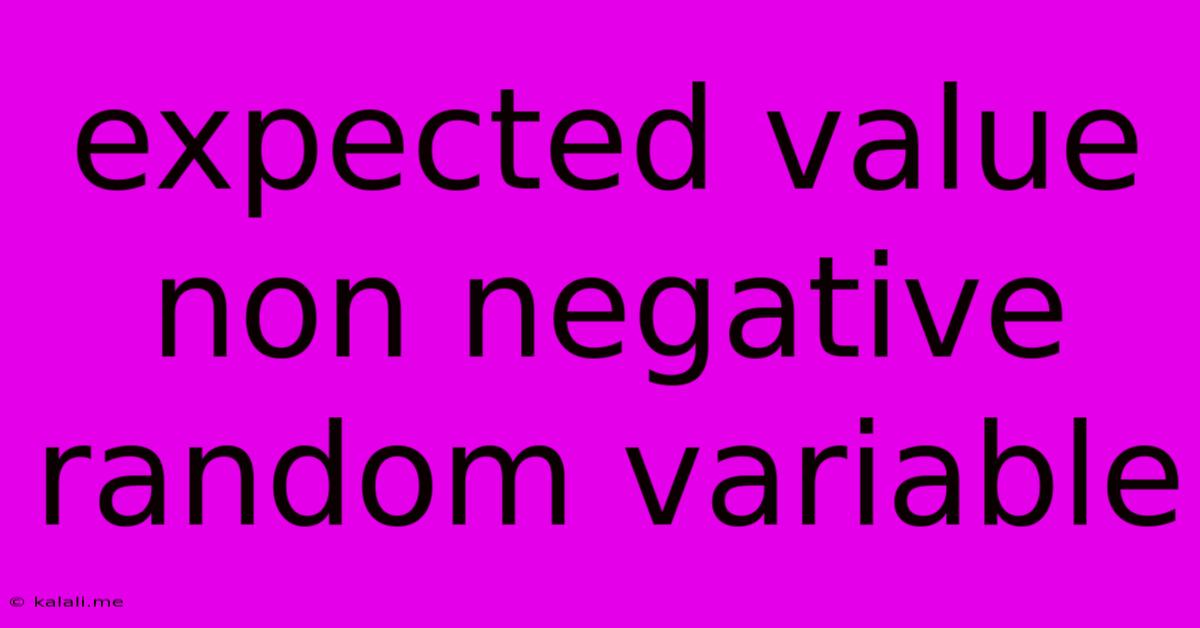Expected Value Non Negative Random Variable
Kalali
May 24, 2025 · 3 min read

Table of Contents
Understanding Expected Value for Non-Negative Random Variables
This article delves into the concept of expected value, specifically focusing on non-negative random variables. We'll explore its definition, properties, and practical applications, providing a clear and comprehensive understanding for both beginners and those seeking a refresher. Understanding expected value is crucial in various fields, from statistics and probability to finance and actuarial science.
What is Expected Value?
The expected value (or expectation) of a random variable is essentially its average value over many repeated trials. For a discrete random variable X, with possible values xᵢ and corresponding probabilities P(X = xᵢ), the expected value, denoted as E[X], is calculated as:
E[X] = Σ [xᵢ * P(X = xᵢ)]
This formula sums the product of each possible value and its probability. For continuous random variables, the summation is replaced by an integral, but the underlying concept remains the same.
Non-Negative Random Variables: A Special Case
A non-negative random variable is one that can only take on values greater than or equal to zero. This seemingly simple constraint significantly impacts the properties and analysis of its expected value. The key implication is that the expected value of a non-negative random variable is always non-negative. This is intuitively obvious; if all possible outcomes are non-negative, their weighted average (the expected value) cannot be negative.
Key Properties of Expected Value for Non-Negative Random Variables:
-
Non-negativity: As mentioned, E[X] ≥ 0 if X is a non-negative random variable. This property is fundamental and often utilized in proofs and theoretical derivations.
-
Linearity: The expected value is a linear operator. This means that for any constants a and b, and random variables X and Y: E[aX + bY] = aE[X] + bE[Y]. This holds true even if X and Y are non-negative.
-
Monotonicity: If X and Y are non-negative random variables, and X ≤ Y (meaning X is always less than or equal to Y), then E[X] ≤ E[Y]. This reflects the intuitive notion that a smaller random variable will have a smaller expected value.
-
Markov's Inequality: This inequality provides an upper bound for the probability that a non-negative random variable exceeds a certain value. Specifically, for a non-negative random variable X and any positive value a:
P(X ≥ a) ≤ E[X] / a
This inequality is particularly useful when the exact distribution of X is unknown but its expected value is known. It allows for estimations of probabilities based on this limited information.
Applications of Expected Value for Non-Negative Random Variables:
The concept finds widespread applications in various fields:
-
Reliability Engineering: Modeling the lifespan of a component or system often involves non-negative random variables (time until failure). The expected value represents the average lifespan.
-
Insurance: Calculating expected payouts for insurance claims involves dealing with non-negative random variables (claim amounts). The expected value represents the average claim amount, crucial for setting premiums.
-
Queueing Theory: Analyzing waiting times in queues often uses non-negative random variables (waiting time). The expected value represents the average waiting time.
-
Finance: Modeling returns on investments frequently employs non-negative random variables (profit or loss). The expected value provides a measure of the average return.
Conclusion:
Understanding the expected value of non-negative random variables is essential for anyone working with probability and statistics. Its inherent properties, particularly non-negativity and Markov's Inequality, provide powerful tools for analysis and estimation in various practical applications across numerous disciplines. This understanding forms a solid foundation for tackling more complex problems involving probability distributions and random variables.
Latest Posts
Latest Posts
-
Books On Mathematics In The Islamic Golden Age
May 24, 2025
-
Fallout 4 General Store Not Working
May 24, 2025
-
How Do I Get Dog Urine Smell Out Of Carpet
May 24, 2025
-
X 2 X 2 X 1
May 24, 2025
-
Dominion Steam Change Ai Difficulty Daily
May 24, 2025
Related Post
Thank you for visiting our website which covers about Expected Value Non Negative Random Variable . We hope the information provided has been useful to you. Feel free to contact us if you have any questions or need further assistance. See you next time and don't miss to bookmark.